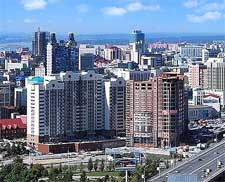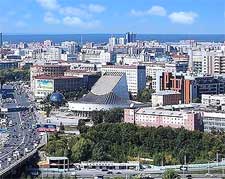Novosibirsk History Facts and Timeline
(Novosibirsk, Siberia, Russia)

Now the Siberian capital, the official timeline of Novosibirsk is a fairly youthful one, although it is known that various settlements have been established here over the centuries.
At the beginning of the 1890s, Russian emperor Alexander III played an integral role in the history and development of Siberia's transportation network, commissioning the building of the Great Siberian Railway. In 1893, the village of Novonikolayevsk was founded at the spot where the Trans Siberian Railway bridge was to be constructed in the very near future, ultimately connecting much of Central Asia, along with the Caspian Sea.
After the Arrival of the Railway Bridge in Novosibirsk
Soon after the completion of the bridge, Novosibirsk began to experience a period of rapid growth and the population quickly topped 8,000 inhabitants, and in 1913, primary education became mandatory. By 1915, no less than five banks were in operation here, with a population explosion soon reaching in excess of 80,000 people. To cope with its size and newfound importance, Novosibirsk was awarded 'town' status, along with the right to form its own government.
Economic growth accompanied the expansion of the town and it was not long before Novosibirsk ranked amongst Siberia's most sizeable and important industrial, commercial and agricultural towns. It soon possessed its very own power station, as well as shipping companies and an iron foundry. Frequent markets were held and goods were traded on an increasingly large scale.
The Russian Civil War
Between 1917 and 1923, the Russian Civil War greatly affected the city and many terrible epidemics soon made their presence known, with both cholera and typhus rapidly taking the lives of literally thousands. The Civil War also resulted in the destruction of the Ob River Bridge and various uprises were to follow during this brief period of Novosibirsk history, together with a rapid decline in the total population. By 1919, the city was in the hands of the Workers' and Peasants' Red Army.
Reconstruction Work Begins
In the early 1920s and during the New Economic Policy of Lenin, the city began to pick itself up and plan its reconstruction, following damage during the war. It was at this stage that Novonikolayevsk was renamed as Novosibirsk, which literally translates as 'New Siberian City'.
Joseph Stalin became a familiar name in the 1920s, being very much known for his part in the Russian October Revolution in 1917. He held the position of General Secretary within the infamous Communist Party of the Soviet Union's Central Committee for no less than three decades, during which time he pushed hard for industrialisation in Russia.
Novosibirsk obliged and it was not long before the city was leading the way in the world of Siberian industry and commerce once more. Numerous factories and processing plants sprang into action and the workforce grew to meet the subsequent demand. At the time of the Great Soviet Famine (1932 to 1933), Novosibirsk quickly swelled with more than 150,000 refugees looking for food and a new life. The city couldn't cope with this sudden influx and many poor slums quickly appeared within the suburbs, such as those of Bolshaya and Malaya Nakhalovka.

Further Growth
By the middle of the 1930s, Novosibirsk was beginning to establish itself a solid infrastructure and trams provided much-needed public transportation around its core. With a population rapidly approaching 300,000 people, the city worked hard to meet the needs of its residents, damming the Ob River to create a giant reservoir (named the Ob Sea or Novosibirskoye Reservoir) and building a modern hydroelectric power station.
The Novosibirsk State University made an appearance in 1959, being founded by the Soviet Union and located within the neighbouring Siberian town of Akademgorodok, a suburb located roughly 20 km / 12 miles to the south. The university today boasts a student base of more than 5,000. Also at this time in Novosibirsk history, Akademgorodok became the centre of Russian scientific research at the request of the Soviet Academy of Sciences, with the founding of the Budker Institute of Nuclear Physics (BINP). This suburb is now home to over 35 different research institutes, as well as various libraries and a medical academy.
What to Expect Today
In the early 1960s, the population of Novosibirsk finally reached one million, making it something of a record-breaker, since it was the youngest city in existence to have a population of that size. Nowadays, more than 1.5 million people call Novosibirsk their home.
Tourists coming here will find plenty of places where elements of the city's history can be gleaned, with the Local Studies Museum (Kraevedchesky Muzey) on the Krasny Prospekt being a good place to start your investigations. Originating from the middle of the 20th-century, the State Academic Opera and Ballet Theatre offers a taster of local culture, while the golden dome of the older Cathedral of Ascension (Voznesensky Sobor) provides a touch of ostentatious glamour.
 Now the Siberian capital, the official timeline of Novosibirsk is a fairly youthful one, although it is known that various settlements have been established here over the centuries.
Now the Siberian capital, the official timeline of Novosibirsk is a fairly youthful one, although it is known that various settlements have been established here over the centuries.